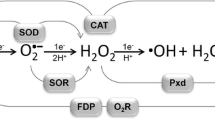Abstract.
The recent discovery that oxygen-sensitive microbes contain superoxide reductase (SOR) activity was unexpected, but it conforms with the idea that all organisms periodically encounter oxygen and must defend themselves against reactive oxygen species. While it remains formally possible that the SOR activity of these enzymes is adventitious, most physical, distributional, and genetic data suggest that their role is indeed to scavenge superoxide. An interesting challenge, then, is to identify the presumptive advantage that superoxide reduction provides to these organisms relative to superoxide dismutation. Some potential benefits of superoxide reduction have been proposed; these and several others are considered here.
Similar content being viewed by others
Author information
Authors and Affiliations
Additional information
Electronic Publication
Rights and permissions
About this article
Cite this article
Imlay, J.A. What biological purpose is served by superoxide reductase?. J Biol Inorg Chem 7, 659–663 (2002). https://doi.org/10.1007/s00775-002-0361-3
Received:
Accepted:
Published:
Issue Date:
DOI: https://doi.org/10.1007/s00775-002-0361-3




